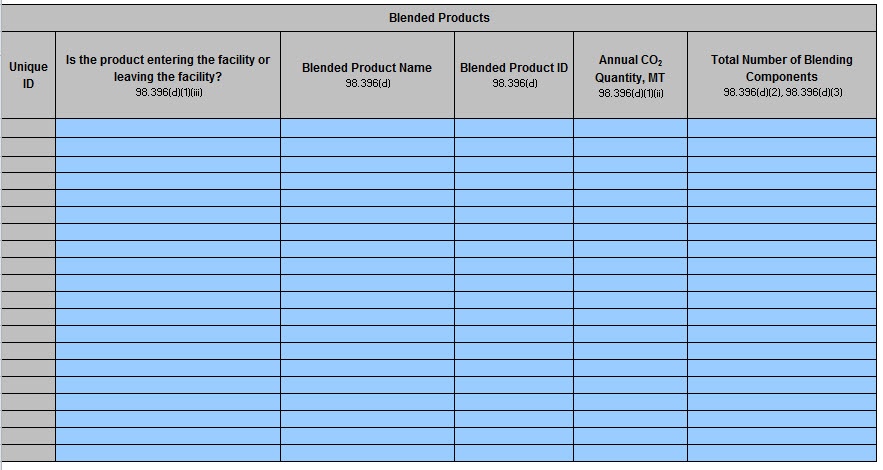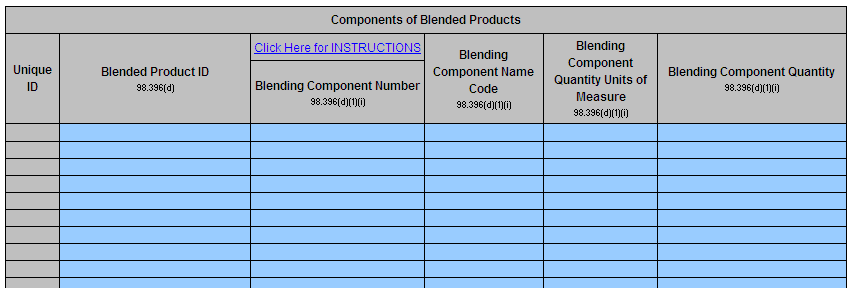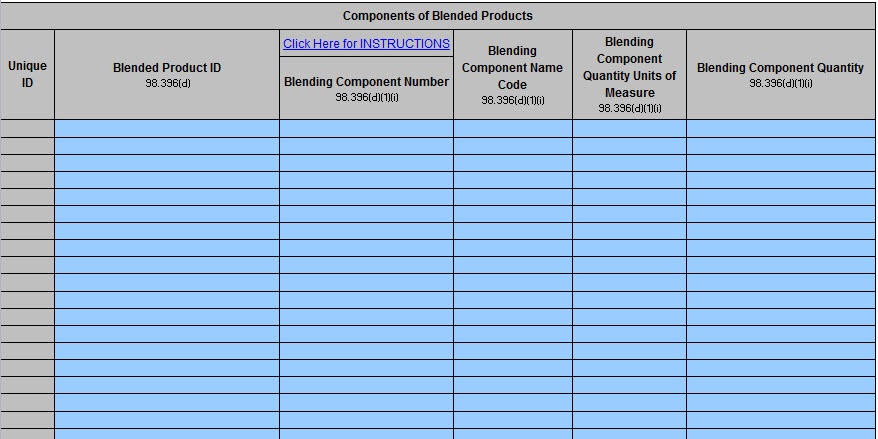This page provides an overview of the "
...
Blended Products" tab on the Subpart MM reporting form.
Please see Reporting Form Instructions for instructions on downloading the blank reporting form and uploading the completed reporting form.
The Blended Products “Blended Products” tab is applicable to refineriesoptional. Refineries, exporters, and importers where emissions associated with products supplied were calculated according to § 98.393 - Optional procedures for may choose to use the optional procedures for reporting blended products that do not contain biomass according to §98.
This worksheet replaces OTAQ Form GHG0401.
393
There are TWO There are two tables on this tab, the "Blended Products" table and the "Components of Blended Products" table. In the "Blended Products" table (first table), each row represents a single blended product.
In the "Components of Blended Products" table (second table), blending components are to be described for each blended product identified in the first table. The number of rows to be completed for each blended product stream in the second table corresponds to the number of blending components in the blended product.
Instructions for reporters choosing to use the optional procedures for reported blended products that do not contain biomass per the requirements of 98.393(i):*
If you choose to use the optional procedures for reporting blended products that do not contain biomass per the requirements of 98.393(i) you must report the following:
Quantity of each blending component:
- Report the quantity of each blending component in Table 2 - Components of Blended Products on worksheet 4. Blended Products.
- INCLUDE this value in the "Product Annual Quantity" field on worksheet 2. Aggregate Products.
CO2 Quantity associated with each blending component:- Report the CO2 quantity that would result from complete combustion or oxidation of the blended product at the PRODUCT level in Table 1- Blended Products on worksheet "4. Blended Products". Do not report the CO2 quantity associated with components of this blended product in Table 2 - Components of Blended Products on "worksheet 4. Blended Products" or in the "Annual CO2 Quantity" field on worksheet "2. Aggregate Products". - DO NOT INCLUDE the CO2 quantity for the blended product in the "Annual CO2 Quantity" field on worksheet 2. Aggregate Products.- INCLUDE the CO2 quantity for the blended product in the "Sum of CO2 Quantity for All Products" field on worksheet "3. Total CO2 & Other Info"
Blended Products Table:
Instructions for reporting Measurement Method:*
Indicate the standard method or industry standard practice used for your quantity measurements. You must be specific in your description so that EPA can adequately identify the standard method or industry standard practice. 40 CFR 98.394(a) specifies that for quantity measurements, you must use an appropriate standard method published by a consensus-based standards organization. Your description should include the name of the consensus-based standard organization. Such organizations include but are not limited to ASTM, ANSI, AGA, API, ASME and NAESB. Also include identification information such as the title of the specific method used (e.g. API Manual of Petroleum Measurement Standards Chapter 5.2; ASTM D1250-80(2002); ASME MFC-18M-2001; ASME MFC-22-2007). If no appropriate standard method exists, then you may use an industry standard practice. An industry standard practice is an approach to determine quantity that achieves a precision which most members of your industry would consider reasonable for the particular product, conditions, and circumstances. You may only use an appropriate industry standard practice to determine quantity if no standard method published by a consensus-based organization exists or would be appropriate to measure the particular product under the particular conditions and circumstances.
For products where quantity was determined under procedures for estimating missing data at 40 CFR 8.395, enter "MISSING-PRODUCT QUANTITY".
For additional instructions related to measurement method, see the Subpart MM Resources Page: http://www.epa.gov/ghgreporting/reporters/subpart/mm.html
A delivery record itself is a record and not a quantity determination method or standard practice. The appropriate method or practice followed to determine the quantity cited in a delivery record must be reported. Third party verification is also not a quantity determination method or standard practice. The appropriate method or practice followed by the third party to determine quantity must be reported (e.g. bills of lading, invoices and custody transfers are not acceptable quantity determination methods or standard practices).
The following table provides instructions for reporting each data element in the "Blended Products" table:
Data Element | Instructions |
|---|---|
Is the product entering the facility or leaving the facility? | For refineries, select "In" if the product is entering the refinery or "Out" if the product is leaving the refinery. For importer/exporter facilities, select "Import" if the product is being imported or "Export" if the product is being exported. |
Blended Product Name | Enter the name for the blended product. |
Blended Product ID | Unique Enter a unique identifier for each blended product. |
Annual CO2 Quantity, (MT) | Enter annual CO2 emissions in metric tons (MT) that would result from complete combustion or oxidation of the blended product. (Not for individual blending components.) This quantity is NOT included Do NOT include this quantity in the "Annual CO2 CO2 Quantity, MT" field in the Aggregate Products worksheet. This quantity IS included “Aggregate Products” tab. Include this quantity in the "Sum of CO2 CO2 Quantity for All Products" field in the Total CO2 “Total CO2 and Other Info" worksheet. |
Measurement Method | Identify the standard method or industry standard practice used for the product quantity (See the detailed instructions on this help page for further information). |
Amount of Time that Missing Data Procedures Were Used (hours) | Enter time (hours) for which missing data procedures were used to estimate the product quantity. |
tab. | |
Total Number of Blending Components | Enter total number of blending components to be reported for the blended product. |
...
"Components of Blended Products" Table:
Identify each blending component for a blended product in a separate row in the second table below. For example, if your blended product is comprised of three individual components, you will enter "3" under "Total Number of Blending Components" in the first table, and enter three different rows in the second table. Each of the three rows in the second table would have the same "Blended Product ID" identifier and would be labeled "Blending Component Number" "1", "2", and "3".
The following table provides instructions for reporting each data element in the "Components of Blended Products" table.
Data Element | Instructions |
|---|---|
Blended Product ID | Unique identifier for each blended product. Use the same IDs from the above table. This should match the Blended Product ID in the first table. |
Blending Component Number | Unique identifier for each blending component, numbered sequentially. See instructions above the Components of Blended Products table on this page. |
Blending Component Name Code | Select Product Name Code corresponding to products listed on Table MM-1 and Table MM-2. (Refer to "7. Tables MM-1 and MM-2".) |
Blending Component Quantity Units of Measure | Select unit of measure for the product: barrels (BBL) or metric tons (MT) |
Blending Component Quantity | Enter the quantity of the blending component in units specified. The quantity IS included in the "Product Quantity" field Include this quantity in the "Measurement Method" worksheet and in the "Product Annual Quantity" field in the "Aggregate Products" worksheettab. |





